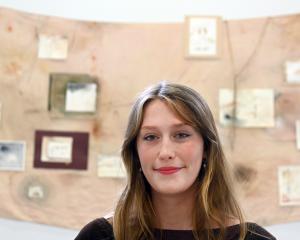An extraordinary column of time machines has clanked into town, devised by one of the greatest minds in history. Nigel Benson meets Leonardo da Vinci.
It is really quite amazing that we regard Leonardo da Vinci's legacy as the Mona Lisa and The Last Supper.
While undoubtedly among the best paintings ever produced, they truly pale alongside his engineering feats.
An exhibition unveiled at Otago Museum this month should go a long way to redressing our perceptions.
"The da Vinci Machines'' is an international exhibition created by Artists of Florence-Teknoart and curated by the Museum of Leonardo da Vinci, in Italy.
"This is the start of a world tour. It's the first time this exhibition has been out of Europe and it's been an overwhelming success,'' Museum of Leonardo da Vinci managing director Luigi Rizzo, who is accompanying the tour, told the Otago Daily Times last week.
"It's really nice that we're in Dunedin, because we think of Dunedin as the Florence of the south.
"Florence was at the beginning of the revolution of technology when Leonardo developed these machines. It was a very exciting place to be. A new society starting,'' he says.
"People think the Renaissance was only about art and culture, but it was a scientific revolution as well - Leonardo shows us that.
"It was the same in Dunedin during the gold rush, when simple machines were needed to dig out the gold in Central Otago and artisans and engineers from all over the world were coming here. That's exactly how Florence was 500 years ago.''
Leonardo di ser Piero da Vinci was born on April 15, 1452, in the hilly Tuscan town of Vinci, in Florence.
Today he is considered one of the greatest painters of all time and, by many scholars, the most diversely talented person to have ever lived.
A scientist, mathematician, engineer, inventor, anatomist, painter, sculptor, architect, botanist, musician and writer, da Vinci conceived ideas that were centuries ahead of his time, greatly advancing our knowledge of anatomy, civil engineering, optics and hydrodynamics.
Among his inventions were the helicopter, hang-glider, tank, calculator, concentrated solar power and the ship's double hull.
"I know that many will consider this useless work,'' he said of his inventions.
Few of his designs were constructed, or even feasible, during his lifetime and none of his original machines survive.
da Vinci also brought great innovation to his paintwork. The shadowy quality of his work in the Mona Lisa, or La Gioconda (The Laughing One), became known as sfumato, or "Leonardo's smoke''.
He was not a prolific painter and only 15 of his works still exist.
However, he was a dedicated draughtsman, keeping journals full of sketches on subjects which took his interest. Curiously, the journals are mostly written in a mirror-image cursive (back to front), as he wrote with his left hand and it was easier for him to write from right to left.
"There are 14,000 technical drawings in existence, but two-thirds of what he did is lost,'' Mr Rizzo says.
"He was very interested in basic engineering problems, but he was only taken seriously as an artist.
"Unfortunately, his work was not regarded as significant, even after his death. They didn't understand his ideas. His war machines were too sophisticated; his ideas too far-fetched.''
"The da Vinci Machines'' details a lifetime of da Vinci's inventions and work, featuring more than 60 life-sized and scale models of war machines, flying machines, nautical and hydraulic machines, as well as devices illustrating principles of mechanics.
Artisans of Florence-Teknoart began to produce the series of replica models in 1995, using authentic materials, such as wood, cotton, brass, iron and cord.
"The most difficult part has been making the machines from Leonardo's drawings,'' Artisans of Florence-Teknoart chief designer Gabrielle Nikolai says.
"The drawings are great, but they don't show every detail".
"We've done about 100 machines so far,'' Mr Rizzo adds. "Hopefully, there's a lot more to come.''
One particularly fascinating exhibit is a robot, based on a suit of armour, which could open and close its jaw, sit up, wave its arms and move its head.
Naval warfare inventions are also well-represented, as it was an area of great interest to da Vinci. It was the space race of its time and countries poured kings' ransoms into the pursuit of maritime supremacy.
"But, probably the most amazing things to me are his flying inventions, because they really worked.
"He actually built a flying machine. That's just incredible,'' Mr Rizzo says.
da Vinci often used nature for inspiration, studying birds when designing flying machines and fish when improving ship hulls.
"Human subtlety will never devise an invention more beautiful, more simple or more direct than does nature, because in her inventions nothing is lacking and nothing is superfluous,'' he says.
"He's inspirational, really. He's one of the most talented people to have ever lived,'' Rizzo says. "Here we are 500 years later and we still haven't stopped being amazed.''
Leonardo da Vinci died at Clos Lucé, France, on May 2, 1519.
His body lies in the Chapel of Saint-Hubert in the castle of Amboise.















